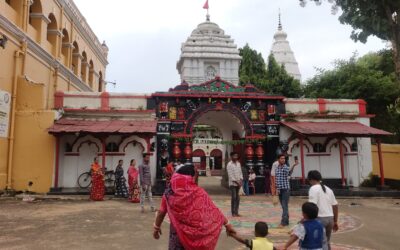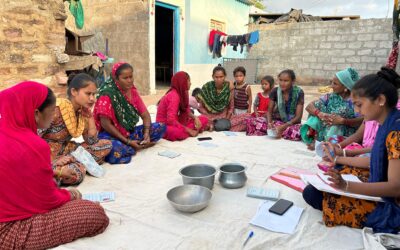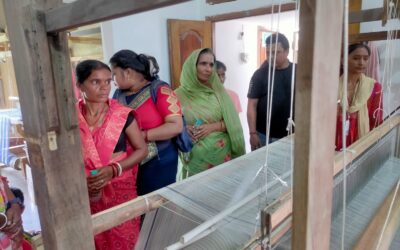Kotra, a tribal region in Udaipur district of Rajasthan, is where I have been living at, for the past six months of my fellowship. Often confused with Kota at my home, Kotra is the part of Rajasthan that I never knew existed (perhaps my ignorance is the reason behind it). A place totally different from Agra, my hometown, Kotra has been a storehouse of many ”is this really happening” moments, one such being the वेर प्रथा (or मौताणा as it is commonly referred to, here).
मौताणा was the one of the first few terms that was told to me while being introduced to Kotra.
“अरे बहुत ख़राब चीज़ है | तुम हमेशा सावधान रहना, कहीं मौताणा न देना पड़ जाए |”
During my field visits, I heard about a case where the family members of a girl (who had died while giving birth) were not ready to cremate the girl’s body and were asking for मौताणा, as they believed that she died due to the negligence of her partner’s side of the family. The body was not cremated until a settlement was reached between the two families which took them six days to have a consensus. The body continued to lie until then.
How it all started ?
वेर प्रथा is one of the oldest cultural exercise that has been in practice among the Scheduled Tribes of Gujarat and Rajasthan. Mostly practiced by Bheel (भील), Grasiya (ग्रासिया) and Meena (मीणा) tribes, this custom is said to be as old as them.
The term वेर means to compensate someone of one’s loss. This practice was started by the ‘head of the villages’, as a compensatory exercise to the families of those who died an Unnatural Death.
Let’s consider a situation where members of two groups are involved and they get into a fight. During this spat, one of the group member dies. Now the other group member/s will compensate for his/her death. The compensation is to be provided by the accused party to the family of the victim/s. It’s said that the practice was started because of the following reasons:
(a) To secure the sufferer/s against any financial loss that they would bear because of the death of their family member. In a tribal family, often the entire family is involved in earning livelihood, right from a toddler to a sexagenarian, and so each one is financially important.
(b) To help the community in mitigating crimes involving feuds, spats or murders by keeping वेर as a punishment. The tribal communities are one of the most marginalized in India and the fear of fine would keep them away from creating nuisance in the society.
How मौताणा or वेर प्रथा actually looks like in today’s scenario?
What had started as a practice to help the community sustain and flourish, has now become malignant and corrupt. With needs of the community on a rise and unemployment being prevalent in the region, the practice has now become a way of extracting money, so much so that people would be seen resorting to violence to attain मौताणा. That’s how it has changed over the years. Even the pettiest issues are considered eligible to receive मौताणा, some of which are as follows:
- Sudden death of a man or a woman
- A woman dying while delivering a baby – her partner’s family is expected to pay the bride’s family
- If a farm animal hits someone passing through someone else’s fields and the former dies, the owner of the animal compensates the family of the deceased
- Death during an emergency
- If someone dies while visiting her relatives, the household where she was visiting would be required to give the compensation to her family
- If an animal is killed by someone
To understand the practice better, here are some more terms one should know:
चढोतरा – When a community receives the news of death of a person from their clan, the men unite and march together, with bows and arrows, some of them beating the drums to express mourning. They go to the place where the body of deceased lies, and stop a few meters away. One of them asks an unbiased person from the site to investigate if the death is natural or unnatural. If it is unnatural, then the group asks for a compensation or मौताणा. If the accused person/group refuses for the settlement or flees away from the site, then the marching Group attacks the property and destroys or confiscates all that belongs to them. This act is called चढोतरा.
Middlemen – It is said that the practice has been made corrupt by local politicians and middlemen who instigate the parties or groups to demand compensation of their loss. It has been seen that after the settlement is reached, these middlemen benefit largely as they take a cut of 25% to 75% of the settlement amount.
Money – Earlier मौताणा was paid in the form of cattle or crop produce and the settlement was done keeping in mind both the parties involved in the dispute. Seven calves were earlier considered as the maximum amount. However, these days the compensation is made in the form of cash where the amount ranges from a few thousands to several lakhs. Not only this, it is not just the family of the accused, but the entire community that has to bear this burden.
The protest – The parties, in order to stage protest for compensation, resort to inhumane ways. The dead bodies of the deceased are not burnt until a settlement is reached which may take up to a few days, weeks or sometimes even month/s.
It was reported a year and half back, that a boy had gone to meet his sister on the occasion of Rakshabandhan where he died an unnatural death. In order to claim the compensation, the family of the boy did not cremate the body for seven months.
The Repercussions:
- The family as well as the clan have to mortgage their lands and homes in order to compensate, which leaves them with nothing.
- It is mostly the children, elderly and women who suffer the most from this practice as men usually flee away from the site, abandoning them. The families have to take shelter in the forests as most of their property gets confiscated or destroyed during चढोतरा.
- Loss of habitat also comes with the loss of animals as even they are left abandoned and most of the cattle dies due to lack of fodder.
- मौताणा has been said to be the primary reason why people in the area do not consider building a cemented house as they live in the fear that they may have to leave the house any day and take shelter elsewhere.
- The children are unable to attend schools for months and are left with no choice but to drop out and start working in other villages or states.
The practice is now clearly misused and what was earlier started as an exercise to reduce the crime, has now taken a different trajectory all together. There have been a lot of such practices which, over time, have degraded as they lack relevance in current time and place. I believe that it would be best if the tribal people shed it away avoiding the burden and fear that follows. It is important to preserve the uniqueness of a culture, however, it shouldn’t come at the expense of extreme discomfort.




0 Comments